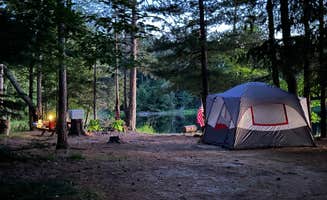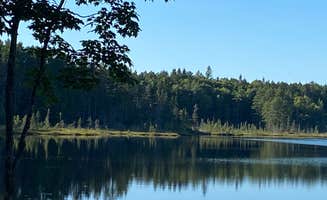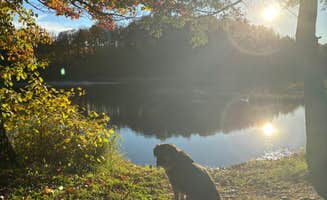Dispersed camping options near Sayner, Wisconsin range through diverse terrain in the Chequamegon-Nicolet National Forest. Winter camping remains popular at several sites, with temperatures commonly dropping below 10°F December through February. Several lakes offer paddling opportunities, with motor restrictions on smaller bodies of water including Harriet Lake where non-motorized watercraft provide quieter recreation.
What to do
Paddling on motor-restricted waters: Harriet Lake offers a peaceful setting for kayaking and canoeing with no motor boats permitted. According to one camper, this small lake "has fire ring and picknick table. Room for small camper 10to 15 foot also tents wilderness toilet. No motor lake."
Winter camping exploration: Forest Road 2140 provides cold-weather options with maintained access. A camper reported, "Winter camped here, was a nice spot pic nik table, fire ring, wilderness toilet. There is hiking trail access from campsite, but no water access to butternut lake or it would have been 5 star."
Swimming at sandy beaches: Woodbury Lake Campsite features a natural beach area perfect for summer swimming. A visitor noted this "remote site has a sandy beach great for swimming or paddling. There is space for a trailer."
What campers like
Secluded lakefront positioning: Robinson Lake Dispersed Campsite offers two separated sites along the waterfront. A camper observed, "Two sites on lake some distance apart. Sand bottom on shore, picknick table and fire ring. No fee for camping can stay 14 days."
Wildlife viewing opportunities: Indian Lake provides excellent opportunities to observe local wildlife. One visitor mentioned, "The campsite is just off a paved road making it easily accessible. It's intended for tents, but a small trailer might fit in the parking area. Many hiking opportunities are nearby."
Access to regional trail systems: Multiple sites connect directly to the extensive northern Wisconsin trail network. At FR 2140, a camper noted, "There is hiking trail access from campsite" with connections to the Hidden Lakes Trail system that extends throughout the national forest.
What you should know
Road conditions vary significantly: Bose Lake Campsite represents the access challenges common to remote sites. A camper warned, "Road to get in is narrow and pot holed." Another camper noted FR 2140 has a "gravel very dusty from road" during summer months.
Cell service limitations: Coverage remains spotty throughout the region. One camper at FR 2140 reported, "Did get one bar of cell (cricket)" suggesting limited communication capability at most dispersed sites.
Tent-only restrictions: Some sites cannot accommodate vehicles directly at the camping area. Three Johns Lake requires "short walk to campsite only one on lake. 5 dollar parking national Forest."
Tips for camping with families
Small-lake swimming options: McKinley Lake Dispersed provides contained water access ideal for families with children. A camper noted it has "a single campsite can park next to tent only. Access to lake."
Beach activities for children: Woodbury Lake features sand-bottom shorelines where kids can play safely. A visitor described it as having a "sandy beach great for swimming or paddling."
Protected shorelines: Sites on smaller lakes offer protected water conditions. At Wolf Lake, "the small lake belongs to a pair of loons that will share their fish and sandy beach," creating wildlife viewing opportunities for children.
Tips from RVers
Small trailer accommodations: Wolf Lake Campsite works for modest rigs despite its rustic setting. A camper noted, "Small campsite along paved road, fire ring and picnic table, wilderness toilet. I had 8 foot pop up could fit a 20 footer easy or tent camp."
Parking limitations: Most sites restrict larger vehicles. At Harriet Lake, expect "room for small camper 10 to 15 foot" while Bose Lake can handle campers "less than 15 foot" in length.
Seasonal access considerations: Summer brings better accessibility, though dust increases on gravel roads. Winter camping remains possible at several locations, but requires appropriate vehicles and preparation for below-freezing temperatures.





